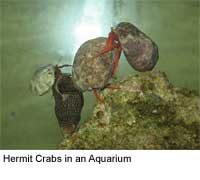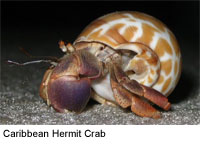|

 Aquariums: There are several species of hermit crabs that are common in the marine aquarium trade. These omnivorous or herbivorous species are useful in the household aquarium as scavengers, eating algae and other debris. Aquariums: There are several species of hermit crabs that are common in the marine aquarium trade. These omnivorous or herbivorous species are useful in the household aquarium as scavengers, eating algae and other debris.
The scarlet hermit crab, or red reef hermit crab (Paguristes cadenati), is a handsome and interesting species with a bright red body and yellow eyestalks, and stays rather small (about 2-5 cm / 1-2 inches across). Smaller species of a similar passive nature include the zebra hermit crab (brown legs with white bands), the red-tip crab and blue-legged crab. In Europe, the common hermit crab (Pagurus bernhardus) is popular.
Size: While most species available in pet stores are small like those listed above, and are simply scavengers, others may grow quite large (some on the Pacific coast can grow to 30 cm / 12 inches) and may eat coral, clams and other crustaceans.
Salinity: Most marine hermit crabs will appreciate a salinity of between 1.023 and 1.025, and temperatures between 4 to 14°C (temperate species) to 24 to 27°C (tropical species), with a good bed, algae to graze on and a variety of shells to change into. They will happily switch shells frequently if given the opportunity - an interesting display to watch.
 Pets in USA: The terrestrial species most commonly kept as pets in the United States are the Caribbean hermit crab (Coenobita clypeatus,) and the Pacific hermit crab (Coenobita compressus). Other species such as Coenobita brevamanus, Coenobita rugosus, Coenobita perlatus or Coenobita cavipes are less common but growing in availabilty and popularity as pets. The terrestrial species live primarily on land and require very different habitats to marine hermit crabs. Pets in USA: The terrestrial species most commonly kept as pets in the United States are the Caribbean hermit crab (Coenobita clypeatus,) and the Pacific hermit crab (Coenobita compressus). Other species such as Coenobita brevamanus, Coenobita rugosus, Coenobita perlatus or Coenobita cavipes are less common but growing in availabilty and popularity as pets. The terrestrial species live primarily on land and require very different habitats to marine hermit crabs.
Fossil Record: The fossil record of in situ hermit crabs using gastropod shells stretches back to the Late Cretaceous. Before that time, at least some hermit crabs used ammonites' shells instead, as shown by a specimen of Palaeopagurus vandenengeli from the Speeton Clay, Yorkshire, UK from the Lower Cretaceous
All text is available under the terms
of the GNU Free Documentation License
|